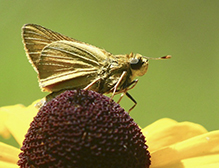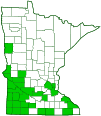Iowa skipper
(Atrytone arogos iowa)
Conservation • Description • Habitat • Ecology • Distribution • Taxonomy
|
|
||||||||||||||
Description |
Iowa skipper is a rare, small to medium-sized, grass skipper. It has a wingspan of 1⅛″ to 1 7 ⁄16″. The female is larger than the male. The wings are proportionately short and broadly triangular. The hindwing is distinctly rounded. The upperside of both wings is yellowish-orange with a broad, dark, grayish-brown border. On the male, the the border is dark and sharply differentiated. On the female, the border is more extensive, is not as dark, and is not sharply defined. It diffuses into the yellowish-orange area, and on the hindwing it sometimes completely obscures lighter color. The veins are unmarked, not darkened. There are no pale or translucent spots. The female has a prominent, black, thin, longitudinal streak in the center of the yellowish-orange area of the forewing where the stigma would be on most male grass skippers. Males of this genus do not have a stigma. Males of this species do not have this black mark. The underside of both wings is yellowish-orange. The veins on the hindwing are whitish. The fringe on the hindwing is usually white. The antennae are short and faintly striped. Each antenna has a long black swelling (club) at the tip, and a pale, thin, hooked extension (apiculus) at the end of the club. The caterpillar is pale yellowish-green with orange markings. |
Size |
Wingspan: 1⅛″ to 1 7 ⁄16″ |
Similar Species |
Delaware skipper (Anatrytone logan) is much more common. There is at least some black veining on the upperside of the wings. The forewing has a black cell-end bar. The wing undersides are brighter orange. The hindwing fringe is orange or tan, not white. |
Habitat |
In Minnesota, moderately dry to moderately moist native tallgrass prairie |
Ecology |
Season |
One generation per year: Late June through July |
Behavior |
Adults are active during the day. When at rest, the forewings are held at a 45° angle and the hindwiings are held horizontal, a configuration that resembles an F-15 Eagle fighter jet. |
Life Cycle |
Males perch on low vegetation near host plants in the afternoon waiting for passing females. The female lays pale yellow eggs singly on the underside of leaves of host plants. Larvae make shelters near the tips of leaves by tying two adjacent leaves together with silk. These shelters can be up to 11¾″ off the ground. They live in their shelters, exiting only at night to feed. They overwinter in their shelters as fourth stage (instar) caterpillars. They pupate in shelters about 3 feet above the ground in the spring. |
Larva Hosts |
Leaves of big bluestem and probably little bluestem Larvae feed near the leaf tips of tall grasses, near shelters up to 11¾″ off the ground. They pupate about 3 feet above the ground. This makes them particularly vulnerable to prescribed burns on managed prairies any time of year. |
Adult Food |
Nectar from flowers, especially narrow-leaved purple coneflower |
Distribution |
||
|
Sources 6, 21, 24, 29, 30, 75, 82, 83. Biodiversity occurrence data published by: Minnesota Biodiversity Atlas (accessed through the Minnesota Biodiversity Atlas Portal, bellatlas.umn.edu, 8/18/2025). |
|
| 8/18/2025 | ||
Occurrence |
||
Rare; small, widely scattered populations |
||
Taxonomy |
|
Order |
|
Superfamily |
Papilionoidea (Butterflies) |
Family |
Hesperiidae (Skippers) |
Subfamily |
Hesperiinae (Grass Skippers) |
Tribe |
Hesperiini |
Suntribe |
Hesperiina (Branded Grass Skippers) |
Genus |
Atrytone |
Species |
Atrytone arogos (Arogos skipper) |
|
|
Skippers have traditionally been placed in their own superfamily Hesperioidea because of their morphological similarity. Recent phylogenetic analysis (Kawahara and Breinholt [2014]) suggests that they share the same common ancestor as other butterfly families, and thus belong in the superfamily, Papilionoidea. |
|
Subordinate Taxa |
|
|
|
Synonyms |
|
Hesperia arogos Hesperia iowa Hesperia mutius |
|
Common Names |
|
Iowa skipper |
|
Glossary
Apiculus
A thin hooked or pointed extension at the ends of each antennae just beyond the club of all skippers except skipperlings (subfamily Heteropterinae).
Instar
The developmental stage of arthropods between each molt; in insects, the developmental stage of the larvae or nymph.
Stigma
In plants, the portion of the female part of the flower that is receptive to pollen. In Lepidoptera, an area of specialized scent scales on the forewing of some skippers, hairstreaks, and moths. In other insects, a thickened, dark, or opaque cell on the leading edge of the wing.
Visitor Photos |
||
Share your photo of this insect. |
||
This button not working for you? |
||
Scott Leddy |
 |
Arogos Iowa skipper butterfly |
MinnesotaSeasons.com Photos |
||
|
||
|
||

Slideshows |
|

Visitor Videos |
||
Share your video of this insect. |
||
This button not working for you? |
||
|
Other Videos |
||
Arogos Skipper |
About
Published on Oct 18, 2014 The interactions that are being observed in the video posted are mutualism and commensalism interactions between the western honey bee, the Arogos skipper and the Jerusalem Artichoke. The western honey bee benefits from this interaction because it receive nutrients from the flower’s nectar, and the flower benefits from the insect because the flower’s pollen is able to cling to the bee and be transported to another flower where the pollen will then fall off the bee and into the stamen of the other flower. This depositing of the pollen allows the eggs of the other flower to be fertilized, ultimately resulting in the production of the seeds. The arogos skipper does not benefit from the interaction with the flower because the arogos skipper does not consume nectar from giant sunflowers, but the Jerusalem Artichoke still benefits because the pollen from the flower is transported by the skipper to other flowers, as it was with the bee. An interesting point to note is that the western honey bee is a pollinator for many different species of plants. The western honey bees are active during all four seasons and because of this do not strictly pollinate just one particular species of flowers.2 When the western honey bee pollinates the Jerusalem Artichoke it also consumes the nectar of the flower. In this case both are benefitting, the bee with a meal, and the flower with reproduction aid, so this interaction is mutualism. However, the arogos skipper is very selective with the source of its nectar and only consumes nectar from purple vetch, Canada thistle, dogbane, stiff coreopsis, purple coneflower, green milkweed, and ox-eye daisy.1 Due to this we can determine the arogos skipper was not benefiting from this interaction, but was not being harmed meaning the interaction had to be commensalism. 1"Butterflies and Moths of North America." Butterflies and Moths of North America | Collecting and Sharing Data about Lepidoptera. N.p., n.d. Web. 18 Oct. 2014. 2Westerkamp, Christian. "Honeybees Are Poor Pollinators ? Why?" Plant Systematics and Evolution 177.1-2 (1991): 71-75. Print. |

Created: 7/26/2018 Last Updated: © MinnesotaSeasons.com. All rights reserved. |


